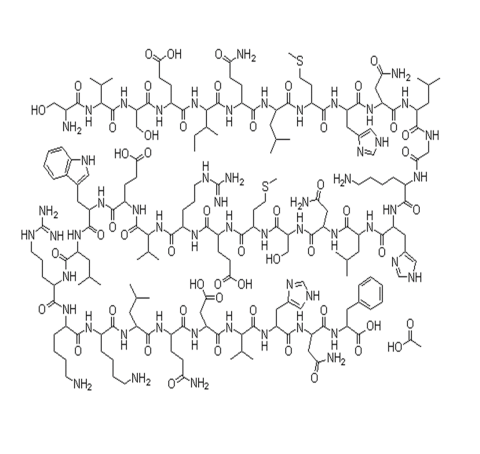Teriparatide is an anabolic, or bone-building, medication used to treat certain types of severe osteoporosis. It is a synthetic analogue of the first 34 amino acids of human parathyroid hormone (PTH) and has been shown to significantly lower the risk of both vertebral and nonvertebral fractures. It belongs to the anabolic class of osteoporosis treatments. This medication is a synthetic version of human parathyroid hormone, comprising the first 34 amino acids of its N-terminal, and functions as a powerful osteoanabolic agent. Its modern development as a bone-building drug began in the 1970s.
BRAND NAMES
Forsteo, Movymia, Sondelbay, Terrosa and Teriparatide Teva.
Teriparatide is an injectable medication.
MECHANISM OF ACTION
Teriparatide works by stimulating bone formation, a process called anabolic activity, which sets it apart from antiresorptive drugs that slow bone loss. It is a recombinant fragment of human parathyroid hormone (PTH) and acts through the PTH type 1 receptor (PTH1R), but its effect depends critically on the pattern of administration.
PHARMACOKINETICS
Absorption
Teriparatide is administered via subcutaneous injection and is absorbed rapidly and almost completely. Its absorption from the injection site is the primary factor determining its overall half-life.
Distribution
Following intravenous injection, the volume of distribution is approximately 0.12 L/kg.
Metabolism
Teriparatide is rapidly metabolized into smaller, inactive peptide fragments in the liver and kidneys through non-specific enzymatic processes. It has a very short half-life of about one hour following a subcutaneous injection. The resulting metabolites are then cleared primarily by the kidneys, with no intact teriparatide excreted in the urine.
Excretion
Teriparatide is eliminated from the body through hepatic metabolism, with the resulting fragments excreted by the kidneys.
PHARMACODYNAMICS
The pharmacodynamics of teriparatide involve pulsatile administration, which stimulates osteoblast activity to promote new bone formation, leading to increased bone mineral density and strength, and a reduced risk of fractures in osteoporosis. Like endogenous parathyroid hormone (PTH), it also temporarily raises serum calcium levels and lowers serum phosphate by influencing the kidneys and intestines.
ADMINISTRATION
Teriparatide is a daily, self-administered subcutaneous injection used to treat severe osteoporosis. It comes in a pre-filled pen device, and a healthcare professional provides training on its use. The injection is given into the abdomen or thigh, and the injection site should be rotated daily. The medication must be refrigerated and should be discarded 28 days after the first use. Because it can cause temporary dizziness, especially with initial doses, patients are advised to sit or lie down during administration.
DOSAGE AND STRENGTH
Teriparatide is a solution for subcutaneous injection. It is available as a prefilled, multi-dose delivery pen that provides 28 daily doses. The brand-name product typically contains a specific amount of teriparatide in a defined volume, allowing for a certain number of daily doses per pen.
DRUG INTERACTIONS
Teriparatide interacts with several medications, most notably with digoxin, increasing the risk of digitalis toxicity due to the drug's effect on serum calcium levels. It should be used cautiously with diuretics like hydrochlorothiazide and furosemide, and with high doses of calcium or vitamin D supplements, as these can increase the risk of hypercalcemia. Combinations with bisphosphonates are not recommended as they offer no added benefit to bone density.
FOOD INTERACTIONS
Teriparatide has no known food interactions and can be taken with or without meals. The injectable medication is not affected by food in the same way oral medications can be. While there are no direct food interactions, patients are advised to follow a diet rich in calcium and vitamin D, or take supplements, to support bone health during teriparatide treatment.
CONTRAINDICATIONS
Teriparatide is contraindicated in patients with a high risk of osteosarcoma, those with underlying hypercalcemia, and individuals with certain metabolic bone diseases. It should also be avoided in women who are pregnant or breastfeeding.
SIDE EFFECTS
Dizziness.
Nausea.
Injection site reactions.
Leg cramps.
Headache.
arthralgia.
General fatigue or weakness.
Osteosarcoma.
High blood calcium.
Orthostatic hypotension.
Allergic reaction.
Worsening of kidney stones.
OVER DOSE
Nausea and vomiting.
Dizziness.
Headache.
Weakness or lethargy.
Orthostatic hypotension.
Confusion.
Increased thirst and urination.
Constipation.
Loss of appetite.
Muscle weakness.
TOXICITY
Teriparatide toxicity is associated with both acute overdose symptoms and long-term risks, such as hypercalcemia, orthostatic hypotension, and a theoretical risk of osteosarcoma. The severity of toxicity is influenced by both the dose and the duration of exposure. An overdose typically produces transient symptoms, while long-term toxicity relates to the potential for severe adverse events.
